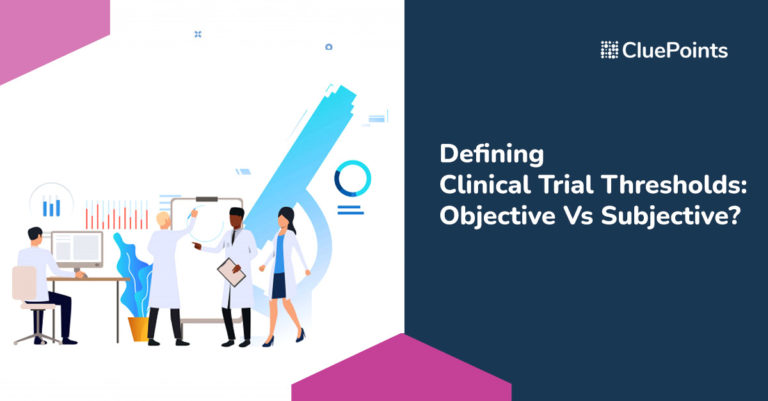A Comparison of Objective vs. Subjective Clinical Trial Thresholds
Clinical trial thresholds are essential for monitoring risk, but how should they be defined? Should teams rely on subjective thresholds using Key Risk Indicators (KRIs), or lean on objective, statistical comparisons across sites? Let’s break down the difference and explore what industry leaders have to say.
Table of Contents
- Defining Objective Clinical Trial Thresholds
- Defining Subjective Clinical Trial Thresholds
- Objective & Subjective Thresholds in Clinical Trials
- The Challenge of Defining Subjective Thresholds
- When “Objective” Thresholds Still Involve Subjectivity
- The Importance of Listening to the Data
- Why Subjective Thresholds Still Matter
- Transitioning to Objective Thresholds
Defining Objective Clinical Trial Thresholds
- Definition: Objective thresholds are data-driven limits or cut-off points established using statistical analysis, historical benchmarks, or quantifiable measures.
- How They’re Set: Typically based on aggregated study data, historical trial data, or statistical models (e.g., using standard deviations, z-scores, or confidence intervals).
- Purpose: Provide a consistent, reproducible, and unbiased way to identify outliers, trends, or risks across sites or subjects.
- Example: If the average rate of adverse events (AEs) across trial sites is 15%, a site reporting fewer than 5% or more than 25% may be flagged for further review.
Defining Subjective Clinical Trial Thresholds
- Definition: Subjective thresholds are experience-based, judgment-driven limits that study teams set using expert input, prior knowledge, or expectations when objective data is insufficient.
- How They’re Set: Rely on the clinical, operational, and qualitative expertise of investigators, data managers, and study monitors. Often used early in a trial when data is still limited.
- Purpose: Allow proactive monitoring before enough data exists to make robust statistical comparisons. They can help identify potential issues earlier by leveraging expert knowledge.
- Example: A study team may decide, based on prior experience, that if a site misses more than two consecutive monitoring visits, it should be flagged—even if there isn’t yet enough data to confirm statistically that the site is underperforming.
Objective & Subjective Thresholds in Clinical Trials
Essentially, objective thresholds are measurable, statistical, and reproducible. Subjective thresholds are experience-based, interpretive, and flexible. Both approaches are valuable. Trials often start with subjective thresholds and transition toward objective thresholds as more data becomes available.
Angie Maurer, Co-Founder & CEO at Zynapsys, and Craig Serra, Senior Director & Data Management Business Process Owner at Pfizer, agreed that there’s a place for both in today’s clinical trials, with Craig commenting: “Until study teams start receiving enough clinical and operational data, perhaps three or four months into a study, they don’t really have the ability to be terribly objective. So until that point, there’s nothing wrong with teams setting subjective thresholds based on previous experience.”
The Challenge of Defining Subjective Thresholds
Defining subjective thresholds in clinical trials is inherently complex. Unlike objective thresholds, which can be derived from statistical models and quantitative data, subjective thresholds rely on human judgment, prior experience, and qualitative insight. This creates variability and the potential for bias, as different study teams or individuals within the same team may reach different conclusions.
Multiple Stakeholders, Multiple Perspectives
One reason subjective thresholds are difficult to define is that they require input from many different stakeholders:
- Data managers who oversee data integrity
- Clinicians who bring medical expertise
- Statisticians who focus on numbers and patterns
- Monitors who observe site-level interactions
Each role provides an important perspective, but bringing them together into a single, actionable threshold is far from straightforward.
Missing Industry Frameworks
Jamie O’Keefe, Vice President, Life Sciences and R&D Practice at Paragon Solutions, noted that the industry lacks a structured system to consolidate these diverse viewpoints. Without such a framework, subjective thresholds risk being applied inconsistently.
Despite these challenges, subjective thresholds still play a critical role, especially in the early stages of a trial, when there isn’t enough data to support objective, statistically valid analysis. By drawing on prior experience and expert knowledge, they allow study teams to proactively monitor sites and take action before issues escalate, effectively bridging the gap until statistical thresholds can be implemented.
When “Objective” Thresholds Still Involve Subjectivity
While subjective thresholds clearly involve judgment, Steve Young, Senior Director of Transformation Services at OmniComm Systems, pointed out that even objective thresholds can carry a level of subjectivity.
Example: Adverse Event (AE) Reporting
Young illustrated this with the example of AE reporting rates: A team might statistically compare the rate of AEs being recorded per subject across all clinical trial sites. But how does the team know that when a site appears to have an unrealistically low adverse event rate, it should be flagged as potentially underreporting?
Here’s the challenge:
- Statistical thresholds are not absolute. Teams can flag outliers by setting a cut-off, such as “any site more than two standard deviations from the mean.” This seems objective, since it’s based on math and distribution curves.
- The choice of cut-off is still subjective. Whether a team selects two, three, or even four standard deviations as the threshold is a judgment call. A stricter threshold may flag more sites, increasing oversight but also the risk of false positives, while a looser threshold may overlook genuine problems until later in the trial.
- Inconsistency across organizations. Because there’s no universal standard, different Sponsors, CROs, and study teams may apply thresholds differently. What one organization considers “out of bounds” may be acceptable to another, leading to variability in monitoring practices and challenges in cross-trial comparisons.
- Impact on trial outcomes. These inconsistencies can affect how quickly risks are identified, resources are allocated, and regulators interpret data quality. Without alignment, there’s a risk of under-reporting (missing true risks) and over-reporting (chasing false signals).
The Path Toward Consensus
As Young noted, there’s currently no universally correct solution. However, the industry may move toward a consensus on defining thresholds over time, balancing statistical rigor with practical judgment.
The Importance of Listening to the Data
Serra provided a useful summary: “Ultimately, listening to and acting on the data is key. After all, as an industry, we are willing to let stats dictate the conclusion in terms of safety and efficacy of a trial, so why aren’t we letting that same hypothesis testing actually tell us about the quality of data during the trial, and what is more, use it during the trial to help safety and efficacy?”
This perspective underscores a critical principle: the same data-driven rigor used to assess safety and efficacy should also guide ongoing monitoring and quality decisions during the trial itself.
Why Subjective Thresholds Still Matter
At the start of a clinical trial, there’s often too little data to immediately establish statistically valid, objective thresholds. In this early stage:
- Subjective thresholds provide an essential starting point. Since statistical patterns haven’t yet emerged, study teams must rely on expert judgment, prior experience, and historical data from similar trials. This ensures monitoring can begin immediately rather than waiting months for enough data to accumulate.
- They allow practical monitoring of KRIs. Even without a robust dataset, teams can still identify early warning signs—such as missed monitoring visits, protocol deviations, or unusual site behaviors—that may signal potential issues before they escalate.
- They enable proactive risk management. By applying subjective thresholds, teams can flag and address site-level risks in real time, rather than reacting after problems have already impacted trial quality or patient safety.
Study teams can set meaningful early warning thresholds by leveraging experience-driven insights and historical trial data from similar therapy areas.
Transitioning to Objective Thresholds
As the trial progresses and more data becomes available, sponsors aim to shift from subjective to objective, data-driven thresholds wherever possible. For variables such as Adverse Events (AEs) or Serious Adverse Events (SAEs):
- Subjective thresholds guide early monitoring. At the start of a study, when data is still sparse, experience-driven thresholds allow Sponsors to detect potential risks and maintain oversight. They provide critical coverage during the “blind spot” period before enough data exists for statistical validation.
- Statistically derived thresholds gain reliability over time. As datasets grow, Central Statistical Monitoring (CSM) enables more precise comparisons across sites and subjects. These objective thresholds reduce variability, improve reproducibility, and help sponsors detect risks more confidently.
- Blending both approaches is now standard in RBM. Many organizations adopt a hybrid model: beginning with subjective thresholds, then layering in objective, statistically derived ones as data matures. This ensures continuous monitoring without gaps while improving the credibility of risk signals over time.
The evidence is clear: objective thresholds carry greater weight in demonstrating where true risk lies within a study. Yet subjective thresholds remain essential in the early stages, creating a bridge until statistical confidence can be established.
By combining both methods—subjective judgment early, objective analysis as data accrues—Sponsors can build a resilient monitoring framework that ensures data quality, safeguards patient safety, and accelerates reliable trial outcomes. Want to discuss subjective and objective thresholds for your next clinical trial? Contact CluePoints today.


